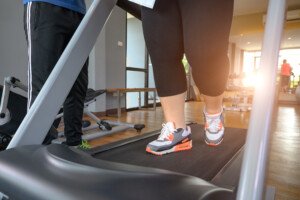
An older woman need not fear high intensity interval training.
In fact, HIIT is one of the best things an aging woman can do for her body, even if she’s always been sedentary.
Since you clicked on this article, I’m going to assume that you know what HIIT is.
The issue for you then, is reassuring you that high intensity interval training is safe for older women—women over 65, even.
The matter is about what kinds of HIIT, vs. whether or not to even do it. Yes, older women can, and should, do HIIT – but what mode, what kind?
I certainly won’t advise that an older woman who’s never made structured exercise a part of her life attempt all-out sprints from one end of a parking lot to another.
But the mature woman can do high intensity interval training safely in the form of walking—her fastest walk up hills.
For example, there’s a park near my parents’ home which includes a concrete path that inclines about 10 percent grade for about 50 meters.
A beginner can walk up this grade as fast as she can, then slowly walk back down to the start point.
If she needs more time to catch her breath or recharge, she can continue slowly walking about at the starting area, then charge back up the slope.
An overweight, even obese, older woman can do this. The objective, as you probably already know, is to move as fast as possible during the work interval.
For some women, this will be 1.5 to 2 mph. For others it will be 2.5 mph. For a very sedentary woman or one who is quite heavy, it will be perhaps 1.0 mph.
The point is to just move, just ambulate, as fast as you can, for that 50 meters. You may even have to stop midway to catch your breath; that’s fine.
The good news is that the rest interval can be several minutes; stay on your feet—do not have a seat.
Another great venue for safe HIIT for older women is the stationary bike.
And need I mention that the treadmill, too, is a safe way to perform high intensity interval training—for even the most poorly conditioned person, including the morbidly obese.

Shutterstock/Iam_Anupong
However, I do not endorse holding onto the treadmill.
Holding on mimics using a walker; it’s a downgrade that deactivates the body’s balance mechanism, plus burns a lot fewer calories.
It skewers posture and can lead to repetitive stress injuries in the hips. Hold on only to sip water or steady yourself momentarily.
Start out very slowly, even if that means one mph. Using an incline is no excuse for holding onto the treadmill.
For poorly conditioned older women, an incline will add resistance without adding impact to the knees or feet.
Do not hold on, even if everyone else in the gym does it; popularity doesn’t make it right.
The elliptical machine is another safe mode for HIIT.
You may also want to try doing stepping drills, using a stepper that’s used in step classes without the risers at first.
To get used to stepping, try a step class, then you can create HIIT sessions on your own.
Finally, for some older women, just a relatively brisk walk on a zero grade is all it takes to get them quite winded.
Predetermine the distance, say, from one end of a block to another, or from a particular park bench to some other landmark in the park, such as a tree.
Then walk your fastest—even if in an absolute sense, the speed is very slow.
HIIT for older women is a fabulous way to lose fat, improve heart function, become fitter and feel much younger. Go for it!
 Lorra Garrick is a former personal trainer certified through the American Council on Exercise. At Bally Total Fitness she trained women and men of all ages for fat loss, muscle building, fitness and improved health.
Lorra Garrick is a former personal trainer certified through the American Council on Exercise. At Bally Total Fitness she trained women and men of all ages for fat loss, muscle building, fitness and improved health.
.









































